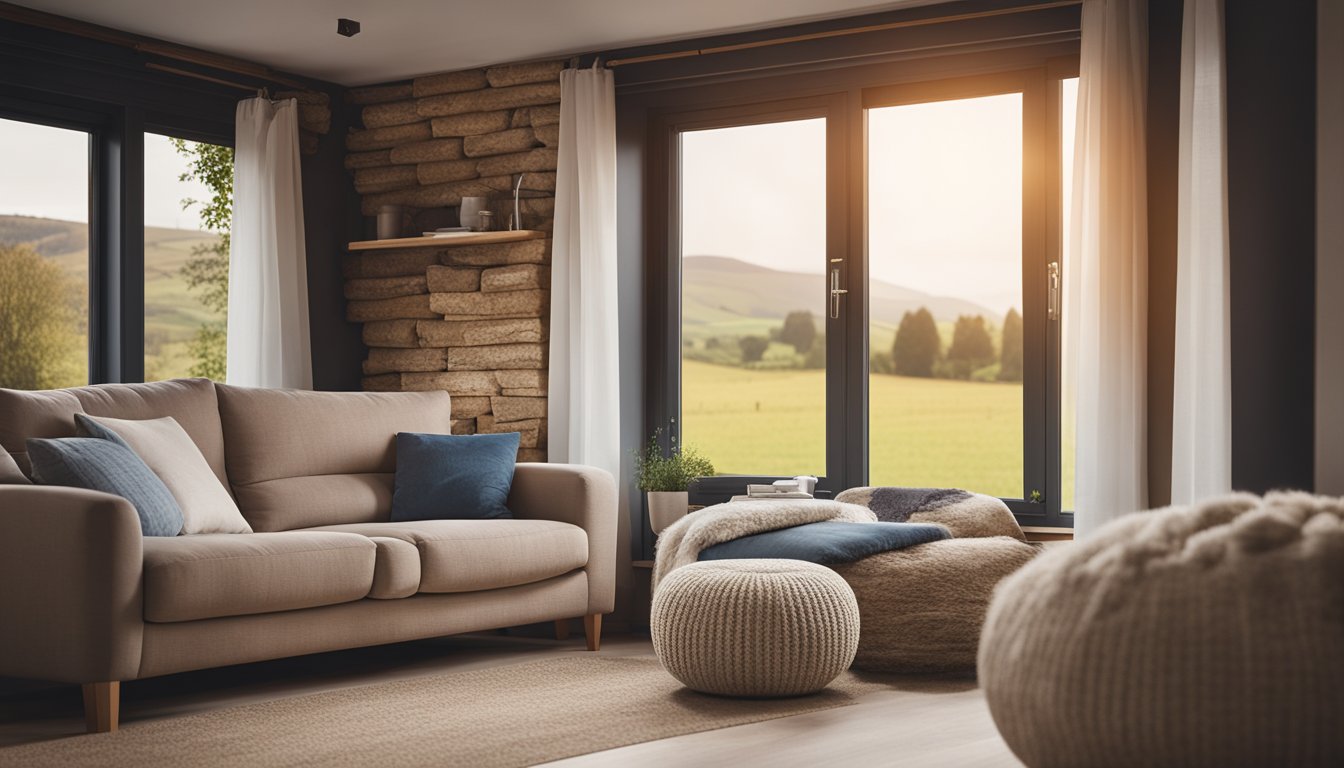Late updated: 12 Jul 2024 13:07
Written by: Eleanor Hartman
Best Home Insulation Materials For UK Homes: Top Choices for Energy Efficiency
In the quest to make our homes more energy-efficient and reduce heating bills, selecting the best home insulation materials for UK homes is crucial. The right insulation not only enhances comfort but also saves money and reduces our carbon footprint. With various options available, it’s essential to understand which materials work best in different parts of the house.

Spray foam insulation has gained popularity as a modern alternative, especially since it can insulate up to 2.7 times more effectively than traditional fibreglass. Meanwhile, traditional options such as stone wool, glass wool, and wood wool continue to provide reliable thermal protection. Each type of insulation material comes with its unique benefits, suited for specific areas of the home.
It's fascinating how superior insulation can lead to significant savings, with some households potentially saving between £630 to £730 annually on energy bills. As we explore the best materials for various needs, we'll provide practical insights and expert advice to help make informed decisions on enhancing the energy efficiency of our homes.
Key Takeaways
- Proper insulation is vital for energy efficiency and cost savings.
- Each insulation material has unique benefits and ideal applications.
- Investing in quality insulation can significantly lower heating bills and carbon emissions.
Understanding Insulation Types and Materials
Choosing the right insulation material and understanding its applications are crucial for improving home energy efficiency and sustainability. Each material has unique properties that make it suitable for specific areas in a home.
Material Options for Different Home Areas
Walls:
- Cavity Walls: Popular options include fibreglass, mineral wool, and polystyrene beads.
- Solid Walls: External insulation with rigid insulation boards (like PIR or phenolic foam) or internal options such as thermal plasterboards.
Roof:
- Loft Insulation: Glass wool, sheep's wool insulation, and cellulose insulation are common for lofts due to their excellent thermal performance.
- Roof Insulation: For warm roofs, using foil insulation or rigid insulation boards can enhance energy efficiency.
Floors:
- Suspended Timber Floors: Benefits from rigid foam boards or wood fibre insulation.
- Solid Floors: Polystyrene or PIR boards effectively reduce heat loss.
Insulation for Optimal Thermal Performance
Choosing materials with high thermal performance is essential to minimise heat loss and maintain a comfortable indoor climate. Fibreglass and mineral wool are effective for general applications due to their good insulation properties.
Spray foam provides excellent air sealing and thermal resistance, ideal for awkward spaces. Phenolic foam and PIR boards offer high insulation value with minimal thickness, useful in areas where space is limited.
Cellulose insulation, made from recycled paper, offers good thermal performance and is suitable for cavity walls and lofts. Foil insulation reflects heat, making it effective for roof applications to reduce heat gain in the summer.
Considering Sustainability and Environmental Impact
Sustainability is a key consideration in modern insulation choices. Sheep's wool insulation and hemp are renewable and biodegradable, making them eco-friendly options. Wood fibre and cork also provide natural and sustainable solutions.
Cellulose insulation stands out for its use of recycled materials, reducing environmental impact. Glass wool and mineral wool can also be eco-friendly if sourced from recycled materials.
Eco insulation methods, such as using renewable energy sources for manufacturing or implementing sustainable building methods, play a significant role. Products like plant-based polystyrene or biomass-derived insulation materials are emerging as sustainable options.
Practical Insights For Home Insulation Projects

To insulate your home effectively, it’s essential to understand the right techniques, consider the costs involved, and be aware of health and safety aspects.
Installation Techniques and DIY Tips
When installing home insulation, various techniques are employed depending on the type of insulation and the specific area being insulated. For loft insulation, insulation rolls and batts can be laid across the floor of the loft to prevent heat from escaping.
For walls, options like cavity wall insulation and external wall insulation are commonly used. Cavity wall insulation involves blowing insulating material into the gap between two layers of brickwork, while external insulation wraps the building and is effective but expensive. Spray foam insulation can be applied directly to walls and under floors for a seamless barrier.
DIY project tips include sealing draughts around windows and doors, ensuring proper pipe insulation, and using a vapour control layer to prevent damp. Rigid foam insulation boards are also popular for floors and walls, offering high thermal performance. Be mindful of avoiding gaps and overlaps to ensure maximum efficiency.
Cost and Financial Considerations
Insulation projects can vary significantly in cost based on the method and materials used. Insulation rolls and batts are typically more cost-effective, while spray foam and external wall insulation tend to be pricier. For instance, loft insulation with rolls might cost hundreds of pounds, whereas spray foam can reach into the thousands.
Energy savings are one of the primary benefits of insulation, potentially reducing heating bills by up to 30%. To support these projects, several government grants and subsidies are available, which can help offset initial expenses.
Balancing the upfront cost and the long-term savings is crucial. Investing more in high R-value materials, like PIR boards, can lead to better thermal performance and lower energy bills, ultimately making them a cost-effective choice over time.
Health, Safety, and Performance Attributes
Safety and health considerations are critical when selecting and installing insulation. Manmade insulation materials may contain allergens or irritants that can affect indoor air quality. It is essential to choose materials with low environmental impact and which don’t introduce harmful substances into the home.
Fire resistance is another crucial factor. Some insulation materials, such as stone wool and glass wool, offer excellent fire-resistant properties.
Acoustic insulation is another benefit, particularly in urban areas where external noise is a concern. Also, an appropriate vapour control layer must be installed to manage moisture levels, preventing damp and rot.
Loose-fill and spray foam options can fill small gaps and cavities effectively but must be installed correctly to prevent voids. Following best practices and manufacturer instructions will ensure optimal safety and performance, creating a comfortable and efficient home environment.
Frequently Asked Questions

Let's address some common queries about home insulation materials for UK homes. We will cover the best options based on R-value, costs, ideal types for interior and external walls, government schemes, and key benefits.
What are the top recommended insulation materials for UK homes based on their R-value?
The top insulation materials based on R-value include spray foam, rigid foam boards, and fibreglass. Spray foam typically offers the highest R-value per inch, making it suitable for both new builds and retrofits. Rigid foam boards, such as PIR and phenolic, provide excellent thermal resistance. Traditional fibreglass insulation also offers good performance at a lower cost.
How does the cost of different home insulation materials compare in the UK market?
Fibreglass insulation is among the most budget-friendly, costing around £8 per square meter for a 300-mm thick blanket. Mineral wool is slightly more expensive at approximately £10 per square meter. Spray foam and rigid foam boards, while offering higher R-values, are more costly, which can affect the overall budget for extensive projects.
Which insulation materials are best suited for insulating interior walls in UK residences?
For interior walls, fibreglass and mineral wool are commonly used due to their affordability and ease of installation. Rigid foam boards are also effective, particularly for reducing thermal bridging. For those seeking higher performance, spray foam provides excellent insulation but comes at a higher cost.
What are the most effective solutions for external wall insulation in UK houses?
For external wall insulation, we often recommend materials like expanded polystyrene (EPS) and mineral wool. EPS is lightweight, easy to cut, and provides good thermal performance. Mineral wool, while heavier, offers superior fire resistance and soundproofing qualities, making it a solid choice for external applications.
What government schemes are available to help with house insulation in the UK?
The UK government offers several schemes to support home insulation, including the Energy Company Obligation (ECO) and the Green Homes Grant. These programs provide financial assistance to homeowners and landlords for installing various types of insulation, aimed at improving energy efficiency and reducing heating costs.
Why is insulation important, and what are five key benefits for UK homeowners?
Insulation is crucial for energy efficiency, reducing heating costs, and improving comfort. Five key benefits include:
- Lower energy bills due to improved thermal efficiency.
- Enhanced indoor comfort with more consistent temperatures.
- Reduced carbon footprint contributing to environmental sustainability.
- Increased property value from better energy performance ratings.
- Improved noise reduction for a quieter indoor environment.